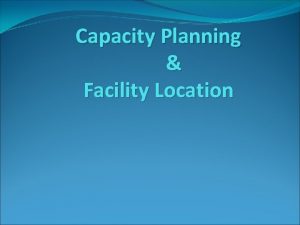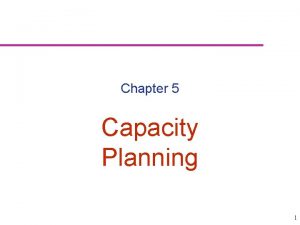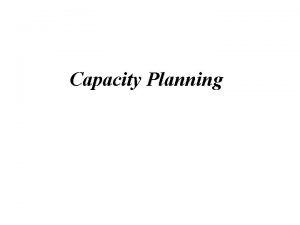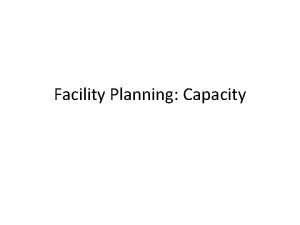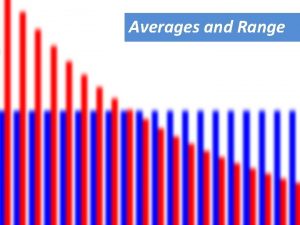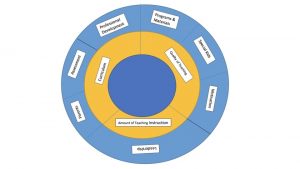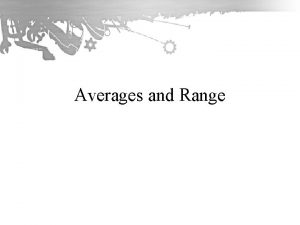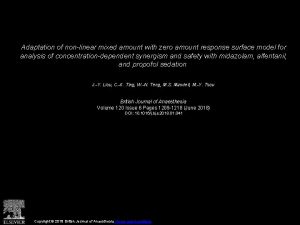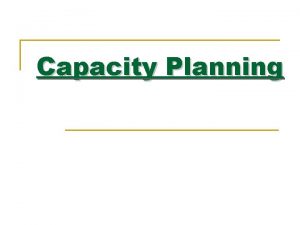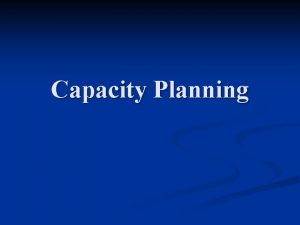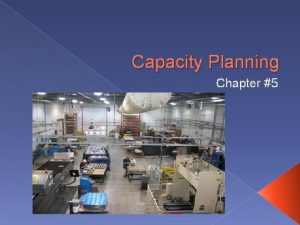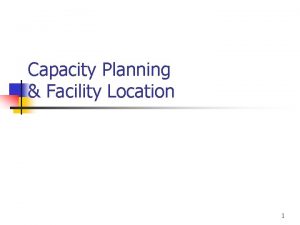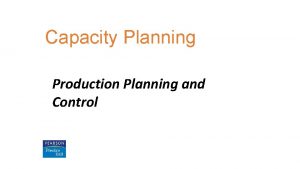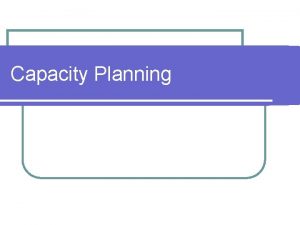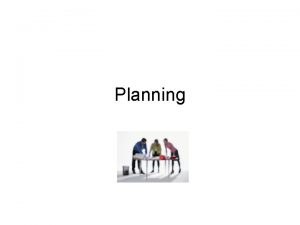CAPACITY PLANNING CAPACITY Capacity is the amount of





































- Slides: 37

CAPACITY PLANNING

CAPACITY Capacity is the amount of goods that a firm is capable of producing over a specified period of time. Capacity can be defined as highest reasonable output rate which can be achieved with the current product specifications, product mix, work force, plant and equipment. Capacity planning for manufacturing and service systems are different.

Both must be designed with capacity limitations in mind. The approaches for long-term and short-term capacity planning will help the managers to make best use of resources. Capacity is the maximum possible output or use from a system under normal design or planned conditions in a given time period. The effective capacity utilization is expressed as percentage of actual capacity used to design capacity.

So, capacity is the maximum possible output. It can be measured in terms of units of input. Capacity utilization = actual capacity used design capacity

ESTIMATION OF CAPITAL REQUIREMENT Break even analysis Decision tree analysis Capacity budgeting

CAPACITY REQUIREMENT PLANNING A capacity requirement planning is a part of manufacturing resource planning. Capacity resource planning is carried out after a manufacturing resource planning program has been run. The important elements of the capacity requirement planning process are of establishing, measuring and adjusting the limits or levels of the production capacity based on the process of determining the amount of labour and machine resources required to accomplish the tasks of production.

TYPES OF CAPACITY 1. Maximum capacity or design capacity is the highest rate of output a process or activity can achieve. It specifies a theoretical upper limit above the usual rate of routine operations. The operation managers calculate the maximum capacity of a manufacturing process. It is based on the number and duration of available shifts, the number of available machines and employees per shift and the working days in a period of the calculation. 2. Effective capacity identifies the output rate that managers expect for a given activity or process. It is the actual capacity to reflect current conditions and that could be less than or more than design capacity. They base production plans and schedules on this measure of output. Effective capacity normally falls short of maximum capacity by some amount.

Determinants ; facilities factors, product/service factors, process factors, human factors, operation factors, external factors…… 3. Demonstrated capacity Demonstrated or actual capacity deals with actual rather than planned production. It measures the actual level of output for a process or activity over a specified period of time. Planners calculate theoretical values for maximum and effective capacity to guide their arrangements for production purposes. Operation managers calculate demonstrated capacity simply by averaging recorded figures for actual output over a period of time.

Factors product mix operator skill and experience condition of equipment types of job Inaccurate production stds Quality of materials other factors ……. .

GUIDELINES FOR CALCULATING CAPACITY 1. The first step is to describe the general flow of activities with in the process. 2. Establish the time period. 3. Establish a common unit of measurement for the entire process 4. Identify the maximum capacity for the overall process 5. Identify the effective capacity for the overall process 6. Determine the demonstrated capacity 7. Compare the demonstrated, effective and maximum capacities and take appropriate actions.

PLANNING EFFECTS OF CAPACITY TYPES HELPS TO CLARIFY FOLLOWING PROBLEMS Insufficient capacity Excess capacity Uses of existing capacity

BOTTLENECKS It is defined as a resource which has a demand requirement greater than its capacity and which limits the outputs capacity of the completed system

CAPACITY PLANNING The effective management of capacity is the most important responsibility of production management. The objective of capacity management is to match the level of operations to the level of demand. Capacity planning is to be carried out keeping in mind future growth and expansion plans, market trends, sales forecasting, etc. It is easy to plan the capacity in case of stable demand. But in practice the demand will not be stable. The fluctuation in demand creates problems regarding the procurement of resources and production to meet the customer demand. Capacity decisions are strategic in nature. In simple words, capacity is the rate of productive capability of a facility.

REASONS Sufficient capacity is needed to meet the customers demand in time. Capacity affects the cost efficiency of production. Capacity affects the scheduling system. Capacity creation requires an investment Extending operations To start new orgn Introducing new methods, techniques, materials etc.

FACTORS INFLUENCES External factors like govt. regulations, union agreements …. Internal factors like product design, plant layout, flow …………

PROCESS OF CAPACITY PLANNING 1. Demand forecasting Capacity planning starts with the setting of up of a business plan which sets out the types of goods or services to be produced. The Manager has to take a long range forecast of demand in order to determine the resources needed to produce and offer specified goods and services. Market trend changes, competitor’s role and technological changes have to be carefully examined. 2. Capacity decisions The demand forecasting of goods and services then must be translated in to a measure of capacity needed. On the basis of forecasting of demand for products, organisation will be able to determine the various resources needed for producing such goods.

3. Facilities planning Capacity decisions automatically lead to the setting up of necessary facilities in order to produce goods and services as determined the previous steps. Facility planning can be done either by the expansion or contraction of existing facilities or by setting up of additional new facilities.

4. Decisions and implementation Finally, alternative resource requirements plan should be properly evaluated. The feasibility of plans along with its economic impact needs to be analyzed. Detailed study of economic impact of resource requirements is essential to make the capacity planning a reality.

Importance of capacity planning Capacity decisions have an impact on the ability of the organization to meet future demands for products and Services. Capacity decisions affect operating costs. Capacity is usually a major determinant of initial cost. Capacity decisions often involve long-term commitment of funds. Capacity decisions can affect competitiveness. Capacity planning reduces the complexity in manufacturing operation.

CAPACITY PLANNING METHODS Long term planning Medium term planning Short term day to day adjustments

PRINCIPLES OF CAPACITY PLANNING Agree on a common definition of capacity planning Select a capacity planning process owner Identify the key resources to be measured measure the current utilizations of the resources Compare current utilization to maximum capacities Collect meaningful workload forecasts from representatives users

Transform forecasts into resource requirements Map requirements into existing utilizations Predict when the shop will be out of capacity Update forecasts and utilizations

CAPACITY UTILIZATION It is one of complicates issues confronted by mgt. Whether to fill capacity and how to fill capacity remain major issues for most businesses it is focuses on 1. technological based concept 2. economic based concept It is measure the efficient utilization of variable inputs It measures capacity of inputs utilized, cost, profits, remaining level etc…

FEATURES Need to determine whethere is capacity utilization issue. It is necessary to track numbers to determine capacity utilization The numbers must be accurate and inclusive It ensures the effective deployment of employees Helps to examine pricing structure It considers all equipments, vehicles etc. Both fixed costs and variable costs should be considered. Markets demand is also considered

LINE BALANCING


LINE BALANCING PROCEDURE Determine which tasks must be performed to complete one unit of a particular product Determine the order or sequence in which the tasks must be performed Draw a precedence diagram Estimate task times Calculate the cycle time Calculate the minimum number of work stations Use any of the simple method to assign tasks to workstations so that production line is balanced

PRECEDENCE DIAGRAM It is a flowchart where in circles represents tasks and connecting arrows represent precedence.

CYCLE TIME Cycle time = productive time demand

MAINTENANCE MANAGEMENT Equipment must be kept at the best operating condition. Otherwise, there will be interruption of production if it is used in a mass production line. Poor working of equipment will lead to quality related problems. It is a necessity to maintain the equipment in good operating conditions with economical cost.

Therefore, an integrated approach to minimize the cost of maintenance is essential. In certain cases, the equipment will be obsolete over a period of time. If a firm wants to be in the same business competitively, it has to take decision on whether to replace the equipment or to retain the old equipment by taking the cost of maintenance into account.

TYPES OF MAINTENANCE 1. Break down maintenance Under this type of method, a machine allows to operate till it breaks. No actions or efforts are taken to maintain the equipment as the designer originally intended to ensure design life is reached. In the case of new equipment, we can expect minimal incidents of failure. Advantages 1. Low cost investment for maintenance. 2. Less staff is required for maintenance. Disadvantages 1. Increased cost due to unplanned downtime of equipment. 2. Increased labor cost. 3. Possible process damage from equipment failure. 2. Preventive maintenance

Preventive maintenance This type of maintenance is preventive in nature. Preventive maintenance is for increasing the reliability of the equipment. By simply expending the necessary resources to conduct maintenance activities intended by the equipment designer, equipment life is extended and its reliability is increased. Advantages 1. Cost effective. 2. Flexibility allows for the adjustment of maintenance periodicity. 3. Increased component life cycle. 4. Energy savings. 5. Reduced equipment or process failure. Disadvantages 1. Labor intensive. 2. Includes performance of unneeded maintenance. 3. Predictive maintenance

Predictive maintenance It differs from preventive maintenance. Preventive maintenance is time-based. Predictive maintenance can be defined as Measurements that detect the onset of a degradation mechanism, thereby allowing causal stressors to be eliminated or controlled prior to any significant deterioration in the component physical state. Results indicate current and future functional capability. Advantages 1. Increased component operational life. 2. Allows for pre-emptive corrective actions. 3. Decrease in equipment or process downtime. 4. Decrease in costs for parts and labor. 5. Better product quality. 6. Improved worker and environmental safety. Disadvantages 1. High investment in diagnostic equipment. 2. High investment in staff training. 3. Savings potential not readily seen by management

Reliability cantered maintenance: Reliability cantered maintenance (RCM) is defined as a process used to determine the maintenance requirements of any physical asset in its operating context. It recognizes that equipment design and operation differs and that different equipment will have a higher probability to undergo failures from different degradation mechanisms than others. Therefore different types of maintenance have to be followed.

MAINTENANCE PLANNING AND SCHEDULING Maintenance planning deals with taking decisions in advance about maintenance activities, It deals with what, How, where, when the maintenance activities are to be taken. It is determine an optimal maintenance schedule for generating units in the planning period. The planning period is usually one year but it could be expanded to several years

MAINTENANCE POLICY AND PROCEDURES List all repetitive work Development of a solution Maintenance planning of machine repairs Justify machine repair cost Prioritize your maintenance planning list Compare production downtime after solution
 Aggregate planning is capacity planning for
Aggregate planning is capacity planning for List the strategic objectives of aggregate planning
List the strategic objectives of aggregate planning Aggregate planning is capacity planning for
Aggregate planning is capacity planning for Trời xanh đây là của chúng ta thể thơ
Trời xanh đây là của chúng ta thể thơ Tư thế ngồi viết
Tư thế ngồi viết Chó sói
Chó sói V cc
V cc Thơ thất ngôn tứ tuyệt đường luật
Thơ thất ngôn tứ tuyệt đường luật Khi nào hổ con có thể sống độc lập
Khi nào hổ con có thể sống độc lập Thế nào là hệ số cao nhất
Thế nào là hệ số cao nhất Diễn thế sinh thái là
Diễn thế sinh thái là Vẽ hình chiếu vuông góc của vật thể sau
Vẽ hình chiếu vuông góc của vật thể sau Frameset trong html5
Frameset trong html5 101012 bằng
101012 bằng Thế nào là mạng điện lắp đặt kiểu nổi
Thế nào là mạng điện lắp đặt kiểu nổi Lời thề hippocrates
Lời thề hippocrates Vẽ hình chiếu đứng bằng cạnh của vật thể
Vẽ hình chiếu đứng bằng cạnh của vật thể Tư thế worms-breton
Tư thế worms-breton đại từ thay thế
đại từ thay thế Quá trình desamine hóa có thể tạo ra
Quá trình desamine hóa có thể tạo ra Sự nuôi và dạy con của hổ
Sự nuôi và dạy con của hổ Các châu lục và đại dương trên thế giới
Các châu lục và đại dương trên thế giới Các loại đột biến cấu trúc nhiễm sắc thể
Các loại đột biến cấu trúc nhiễm sắc thể Biện pháp chống mỏi cơ
Biện pháp chống mỏi cơ Bổ thể
Bổ thể Phản ứng thế ankan
Phản ứng thế ankan Thiếu nhi thế giới liên hoan
Thiếu nhi thế giới liên hoan Phối cảnh
Phối cảnh Hát lên người ơi
Hát lên người ơi điện thế nghỉ
điện thế nghỉ Một số thể thơ truyền thống
Một số thể thơ truyền thống Hệ hô hấp
Hệ hô hấp Bảng số nguyên tố
Bảng số nguyên tố Công thức tiính động năng
Công thức tiính động năng Tỉ lệ cơ thể trẻ em
Tỉ lệ cơ thể trẻ em đặc điểm cơ thể của người tối cổ
đặc điểm cơ thể của người tối cổ Các châu lục và đại dương trên thế giới
Các châu lục và đại dương trên thế giới ưu thế lai là gì
ưu thế lai là gì








































